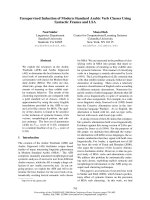650 idioms and proverbial phrases in modern standard arabic 2022
Bạn đang xem bản rút gọn của tài liệu. Xem và tải ngay bản đầy đủ của tài liệu tại đây (6.05 MB, 393 trang )
650 Idioms and Proverbial
Phrases in Modern Standard
Arabic
650 Idioms and Proverbial Phrases in Modern Standard Arabic is the ideal tool for
learners of Arabic who wish to improve their knowledge and comprehension of
Arabic language and culture and make their language more expressive and idiomatic.
Including over 650 idiomatic expressions found in contemporary Arabic, this
book is divided into two parts. Part I lists the idioms alphabetically for ease of use,
providing English equivalents and a range of illustrative example sentences to show
how the idioms are used in different contexts. The idioms are chosen based on
frequency of use in written Arabic as well as oral speech, in Arabic literature and mass
media. Part II includes 30 practice exercises structured around original texts which
include the idioms covered in Part I. These practice exercises encourage students to
review the meanings of idioms while improving their reading skills and familiarity
with various text genres.
Designed to be comprehensive, accurate, and easy to use, the book reflects the
daily use of Arabic and draws on real and authentic use of the language. Suitable for
use as a textbook or reader, this is an ideal resource for students at CEFR level B1 to
C2 or Intermediate-High to Advanced-High on the ACTFL proficiency scale.
Lamia Jamal-Aldin is an Arabic language and literature academic with years of
teaching experience at different universities in the UK and abroad. Lamia has a
deep knowledge of the niceties of Arabic grammar and morphology in its classical,
standard, and colloquial forms. Her passion for Semitic languages and her experience
in pedagogy have driven her to develop unique and innovative methods in teaching
Arabic as a second language.
Abdullah Hammadi is a freelance writer, translator, and analyst. His areas of interest
include Arabic language and the socio-political trends in the Middle East. He formerly
worked as a survey manager on an MIT project in the Middle East. Abdullah has a
deep and wide understanding of classical, standard, and colloquial forms of Arabic,
and of the nuances of the language. Short stories, poetry, essays, political analysis,
translations, and Arabic teaching materials are part of his writing portfolio.
Uploaded by S. M. Safi
Uploaded by S. M. Safi
650 Idioms and Proverbial
Phrases in Modern
Standard Arabic
اﻟﺘﻌﺎﺑﯿﺮ اﻟﻠﻐﻮﯾﺔ واﻷﻣﺜﺎل ﻓﻲ اﻟﻌﺮﺑﯿﺔ اﻟﺤﺪﯾﺜﺔ
For Intermediate to Advanced
Students
Lamia Jamal-Aldin
Abdullah Hammadi
Uploaded by S. M. Safi
First published 2022
by Routledge
2 Park Square, Milton Park, Abingdon, Oxon OX14 4RN
and by Routledge
605 Third Avenue, New York, NY 10158
Routledge is an imprint of the Taylor & Francis Group, an informa business
© 2022 Lamia Jamal-Aldin and Abdullah Hammadi
The right of Lamia Jamal-Aldin and Abdullah Hammadi to be identified
as authors of this work has been asserted by them in accordance with
sections 77 and 78 of the Copyright, Designs and Patents Act 1988.
All rights reserved. No part of this book may be reprinted or reproduced
or utilised in any form or by any electronic, mechanical, or other
means, now known or hereafter invented, including photocopying and
recording, or in any information storage or retrieval system, without
permission in writing from the publishers.
Trademark notice: Product or corporate names may be trademarks
or registered trademarks, and are used only for identification and
explanation without intent to infringe.
British Library Cataloguing-in-Publication Data
A catalogue record for this book is available from the British Library
Library of Congress Cataloging-in-Publication Data
A catalog record has been requested for this book
ISBN: 978-0-367-56159-8 (hbk)
ISBN: 978-0-367-56152-9 (pbk)
ISBN: 978-1-003-09666-5 (ebk)
DOI: 10.4324/9781003096665
Typeset in Optima
by Apex CoVantage, LLC
Uploaded by S. M. Safi
ﺗﺒﻘﻰ اﻟﺤﻜﻤﺔُ اﻹﻧﺴﺎﻧﯿّﺔُ واﺣﺪةً ﻣﮭﻤﺎ اﺧﺘﻠﻔ ِﺖ اﻷﻟﺴﻦ.
Uploaded by S. M. Safi
Uploaded by S. M. Safi
Contents
Preface x
xii
ﻧﺒﺬة ﻋﻦ اﻟﻜﺘﺎب
1
PART I THE IDIOMS AND PROVERBIAL PHRASES 3
1 alif (ﺣﺮف اﻷﻟﻒ) 38
2 baa (ﺣﺮف اﻟﺒﺎء) 50
3 taa (ﺣﺮف اﻟﺘﺎء) 60
4 ṯaa (ﺣﺮف اﻟﺜﺎء) 62
5 jeem (ﺣﺮف اﻟﺠﯿﻢ) 66
6 ḥaa (ﺣﺮف اﻟﺤﺎء) 71
7 ḫaa (ﺣﺮف اﻟﺨﺎء) 76
8 daal (ﺣﺮف اﻟﺪال) 81
9 ḏaal (ﺣﺮف اﻟﺬال) 84
10 raa (ﺣﺮف اﻟﺮاء) 92
11 zaay (ﺣﺮف اﻟﺰاي) 95
12 seen (ﺣﺮف اﻟﺴﯿﻦ) vii
Uploaded by S. M. Safi
Contents
(ﺣﺮف اﻟﺸﯿﻦ) 13 šeen 102
(ﺣﺮف اﻟﺼﺎد) 14 ṣaad 109
(ﺣﺮف اﻟﻀﺎد) 15 ḍaad 113
(ﺣﺮف اﻟﻄﺎء) 16 ṭaa 118
(ﺣﺮف اﻟﻈﺎء) 17 ẓaa 122
(ﺣﺮف اﻟﻌﯿﻦ) 18 ʿayn 123
(ﺣﺮف اﻟﻐﯿﻦ) 19 ġain 147
(ﺣﺮف اﻟﻔﺎء) 20 faa 150
(ﺣﺮف اﻟﻘﺎف) 21 qaaf 160
(ﺣﺮف اﻟﻜﺎف) 22 kaaf 170
(ﺣﺮف اﻟﻼم) 23 laam 175
(ﺣﺮف اﻟﻤﯿﻢ) 24 meem 194
(ﺣﺮف اﻟﻨﻮن) 25 noon 208
(ﺣﺮف اﻟﮭﺎء) 26 haa 216
(ﺣﺮف اﻟﻮاو) 27 waaw 219
(ﺣﺮف اﻟﯿﺎء) 28 yaa 226
(اﻷﻣﺜﺎل) 29 Proverbial phrases 228
PART II THE PRACTICE EXERCISES 249
(اﻟﻜﺘﺎب اﻟﻌﺠﯿﺐ) Practice exercise 1 251
(اﻟﮭ َﻮس) Practice exercise 2 255
(اﻟﻤﻘﺎھﻲ ﻓﻲ اﻟﻌﻮاﺻﻢ اﻟﻌﺮﺑﯿﺔ) Practice exercise 3 260
(ﻛﻤﺎ ﺗﺪﯾﻦ ﺗﺪان) Practice exercise 4 264
(اﻟﺘﺤﺪﯾﺎت اﻟﺒﯿﺌﯿﺔ ﻓﻲ اﻟﻌﺎﻟﻢ اﻟﻌﺮﺑﻲ) Practice exercise 5 269
(ﻋﻨﺪﻣﺎ ﯾﻐﻠﺐ اﻹﻧﺴﺎن ﻋﻠﻰ أﻣﺮه) Practice exercise 6 273
(اﻟﻠﺒﺎن اﻟﻌﻤﺎﻧﻲ) Practice exercise 7 278
viii
Uploaded by S. M. Safi
Practice exercise 8 (اﻟﻮﻋﺪ واﻟﺨﺒﺎز) Contents
Practice exercise 9 (ﻧﺎدي اﻟﻮاﺣﺔ ﯾﻌﻮد اﻟﻘﮭﻘﺮى ﻓﻲ ﻋﻘﺮ داره)
Practice exercise 10 (اﻷﺧﺒﺎر ﻻ ﺗﺘﻐﯿﺮ) 281
Practice exercise 11 (اﻟﻤﺮأة اﻟﺨﻠﯿﺠﯿﺔ واﻟﻤﻨﺎﺻﺐ اﻟﻘﯿﺎدﯾﺔ) 285
Practice exercise 12 (ﻓﻲ ﺑﯿﺖ اﻟﻌﺎﺋﻠﺔ) 289
Practice exercise 13 (اﻟﻠﻘﺎء اﻷول) 293
Practice exercise 14 (وﻛﺎن اﻟﻠﻘﺎء اﻟﺜﺎﻧﻲ) 297
Practice exercise 15 (رﺳﺎﻟﺔ ﺷﻜﺮ وﺗﻘﺪﯾﺮ) 301
Practice exercise 16 (وﻻت ﺣﯿﻦ ﻣﻨﺎص) 306
Practice exercise 17 (ﺣﺪﯾﺚ ﺑﯿﻦ ﻋﺠﻮزﯾﻦ) 312
Practice exercise 18 (اﻟﺤﺮب اﻷھﻠﯿﺔ إﻟﻰ أﯾﻦ؟) 316
Practice exercise 19 (ﻣﺤﻨﺔ ﺷﺎب ﺑﺪﯾﻦ) 320
Practice exercise 20 (ﻣﻘﺪﻣﺔ ﺗﻘﺮﯾﺮ رﺳﻤﻲ) 324
Practice exercise 21 (وھﻜﺬا دواﻟﯿﻚ) 329
Practice exercise 22 (ﺗﺄﺑﯿﻦ زﻋﯿﻢ ﺳﺎﺑﻖ) 334
Practice exercise 23 (اﻷﻣﻮر ﺑﺨﻮاﺗﯿﻤﮭﺎ) 337
Practice exercise 24 (اﻟﺼﺤﺮاء) 342
Practice exercise 25 (اﻟﻄﯿﻮر ﻋﻠﻰ أﺷﻜﺎﻟﮭﺎ ﺗﻘﻊ) 346
Practice exercise 26 (ﺑﯿﺎن ﺣﻜﻮﻣﻲ) 350
Practice exercise 27 (اﻟﻤﻘﺎﻣﺔ اﻟﻤﺴﻘﻮﻓﯿﺔ) 354
Practice exercise 28 (ﺷﺠﺐ واﺳﺘﻨﻜﺎر) 358
Practice exercise 29 (ﻗﺮار ﻣﺤﻜﻤﺔ اﻟﺘﻤﯿﯿﺰ) 362
Practice exercise 30 (ﻧﮭﺎﯾﺔ ﻣﻄﺮب ﻓﻲ زﻣﻦ اﻹﻧﺘﺮﻧﺖ) 366
370
374
ix
Uploaded by S. M. Safi
Preface
Idioms and proverbs are used in everyday life in the Arab World, ranging from
spoken colloquial to standard Arabic. 650 Idioms and Proverbial Phrases in
MSA is a textbook and reader that focuses on standard Arabic idioms and
proverbs. The aim of this textbook is to develop the knowledge and under-
standing of idioms in Arabic. Furthermore, it aims to enhance the learner’s
skills in Modern Standard Arabic through its integrative approach that brings
all skills together.
This book is suitable for students of Arabic who need to improve their
understanding of Arabic idioms and proverbs and to gain fluency in the lan-
guage. The book is also an indispensable source for students, scholars, trans-
lators, and all professionals who deal with Arabic.
650 Idioms and Proverbial Phrases in MSA explains and exercises the
idioms in a way that reflects not only the idioms’ meanings but also incor-
porates real life examples that bring together language, context, and culture.
The book has two parts:
Part I includes 29 chapters, and covers over 650 common Arabic idi-
oms and proverbs, which are alphabetically ordered. They are diacritically
marked to show their correct pronunciations, according to the most reli-
able Arabic literature sources. The meanings of each idiom/proverb are given
in English, then model sentences are presented, together with their English
translations. These examples show the idiom’s typical contextual use, and
elucidate the grammatical peculiarities, the morphological modifications,
and the cultural aspects of the idiom. The model examples are also diacriti-
cally marked where needed to display grammatical and syntactic features, to
demonstrate accurate pronunciation of the words, and to make it easier for
the learner to fully comprehend the modifications that occur to the Arabic
grammatical modes.
x
Uploaded by S. M. Safi
Preface
Significant efforts have been made to find the most accurate meaning for
each idiom/proverb in Arabic and English. We went through many sources
in both languages, comparing and analysing texts and materials to determine
how the idioms/proverbs are used and in which context. We have noticed
that inaccurate translations of some Arabic idioms are widely used today.
One example is “false friends,” expressions that have similar forms in both
languages with totally different meanings. The Arabic idiom (اﻟﺤﻖ ﯾﻘﺎل)for
instance is commonly and wrongly translated as “truth be told.” While it is
used in English to admit or tell the truth about something negative, it is used
in Arabic to express a positive opinion in defense of someone’s action. It is
never used in Arabic to express negative thoughts.
Part II includes 30 practice exercises; each has a text that uses idioms
from Part I. We have written the texts specifically for this book, and they are
diverse in their themes, styles, and genres. All the texts are fictional, and
they come in the form of short stories, reports, political analysis, articles,
football match report, a letter of thanks, a formal speech, official statements,
a Maqamah (Arabic rhymed prose), a eulogy, and a court ruling. The idi-
oms and proverbs are presented for study and practice in natural contexts
within language usage that is informative, enjoyable, and simulates reality.
Furthermore, the practice exercises concentrate on familiarising the student
with the meanings of the idioms and proverbs and how they are used in dif-
ferent contexts and writing styles. Part II also can be used independently as a
reader to enhance the student’s skills in reading and analysing different texts
and genres in Arabic.
This textbook/reader is indispensable for anyone who wants to develop
and enrich their Arabic language and make it more expressive.
xi
Uploaded by S. M. Safi
ﻧﺒﺬة ﻋﻦ اﻟﻜﺘﺎب
ﯾﻜﺘﺴﺐ ھﺬا اﻟﻜﺘﺎب أھﻤﯿﺘﮫ ﻟﯿﺲ ﻓﻘﻂ ﻣﻦ أﻧﮫ ﻛﺘﺎب ﺗﻌﻠﯿﻤﻲ ﻟﺘﺪرﯾﺲ اﻟﺘﻌﺎﺑﯿﺮ اﻟﻠﻐﻮﯾﺔ واﻷﻣﺜﺎل
اﻟﻤﺴﺘﺨﺪﻣﺔ ﻓﻲ اﻟﻠﻐﺔ اﻟﻌﺮﺑﯿﺔ اﻟﺤﺪﯾﺜﺔ ﻟﻐﯿﺮ اﻟﻨﺎطﻘﯿﻦ ﺑﮭﺎ، ﺑﻞ ﯾﺘﺨﻄﻰ ذﻟﻚ ﻟﯿﻜﻮن ﻛﺘﺎﺑًﺎ ﻻ ﻏﻨﻰ
ﻋﻨﮫ ﻟﻠﺒﺎﺣﺜﯿﻦ واﻟﻤﺘﺮﺟﻤﯿﻦ واﻟﻄﻼب ﻓﻲ ﺣﻘﻞ اﻟﺘﺮﺟﻤﺔ ﻣﻦ اﻟﻌﺮﺑﯿﺔ وإﻟﯿﮭﺎ، ﻧﺎھﯿﻚ ﻋﻦ اﻟﺬﯾﻦ
ﯾﺘﻌﺎﻣﻠﻮن ﺑﺎﻟﻠﻐﺔ اﻟﻌﺮﺑﯿﺔ ﻛﺘﺎﺑﺔً وﺣﺪﯾﺜًﺎ وﻗﺮاءةً، وﯾﺤﺮﺻﻮن ﻋﻠﻰ أن ﺗﻜﻮن ﻟﺪﯾﮭﻢ ﻟﻐﺔ ﻋﺮﺑﯿﺔ
ﺳﻠﯿﻤﺔ.
ﯾﺴﺪ ھﺬا اﻟﻜﺘﺎب ﻧﻘ ًﺼﺎ واﺿ ًﺤﺎ ﻓﻲ أي ﺑﺮﻧﺎﻣﺞ ﺗﻌﻠﯿﻤﻲ ﯾﻌﻨﻰ ﺑﺘﺪرﯾﺲ اﻟﻌﺮﺑﯿﺔ. إذ إن دراﺳﺔ
أﯾﺔ ﻟﻐﺔ وﻓﮭﻤﮭﺎ ﻻ ﯾﻜﺘﻤﻼن دون ﻓﮭﻢ اﻟﺘﻌﺎﺑﯿﺮ اﻟﻠﻐﻮﯾﺔ اﻟﺘﻲ ﺗﺴﺘﺨﺪﻣﮭﺎ ﺗﻠﻚ اﻟﻠﻐﺔ، ﺧﺼﻮ ًﺻﺎ
أن اﻟﻠﻐﺔ اﻟﻌﺮﺑﯿﺔ ﺗﻌ ّﺞ ﺑﮭﺎ، وﻻ ﯾﻜﺎد ﯾﺨﻠﻮ ﻧﺺ ﻣﻦ ﻧﺼﻮﺻﮭﺎ ﻣﻦ ﺗﻠﻚ اﻟﺘﻌﺎﺑﯿﺮ. وﻗﺪ ﺳﻌﯿﻨﺎ ﻣﺎ
وﺳﻌﻨﺎ اﻟﺴﻌﻲ إﻟﻰ ﺟﻤﻊ وﻋﺮض أﻛﺜﺮ ﻣﻦ ﺳﺘﻤﺎﺋﺔ وﺧﻤﺴﯿﻦ ﺗﻌﺒﯿ ًﺮا ﻟﻐﻮﯾًّﺎ ﺷﺎﺋ ًﻌﺎ ﻓﻲ ھﺬا اﻟﻜﺘﺎب
اﻟﺬي ﻗﺴﻤﻨﺎه إﻟﻰ ﻗﺴﻤﯿﻦ:
اﻟﻘﺴﻢ اﻷول ﯾﺤﻮي اﻟﺘﻌﺎﺑﯿﺮ اﻟﻠﻐﻮﯾﺔ واﻷﻣﺜﺎل اﻟﺸﺎﺋﻌﺔ ﻓﻲ اﻟﻌﺮﺑﯿﺔ اﻟﺘﻲ ﺗﻢ اﺧﺘﯿﺎرھﺎ ﺑﺪﻗﺔ، وﺗﻢ
ﺗﺮﺗﯿﺒﮭﺎ ﺑﺤﺴﺐ اﻟﺤﺮوف اﻟﮭﺠﺎﺋﯿﺔ. وﻗﺪ وﺿﻌﻨﺎ ﻟﻜﻞ ﺗﻌﺒﯿﺮ ﻟﻐﻮي ﺗﺮﺟﻤﺎت ﺑﺎﻟﻠﻐﺔ اﻹﻧﻜﻠﯿﺰﯾﺔ
ﺗﻔﺴﺮ ﻣﻌﺎﻧﯿﮫ اﻷﻛﺜﺮ ﺷﯿﻮ ًﻋﺎ واﺳﺘﺨﺪا ًﻣﺎ ﻣﺘﺤ ّﺮﯾﻦ اﻟﺪﻗﺔ ﻓﻲ أن ﺗﻜﻮن ﺗﻠﻚ اﻟﺘﺮﺟﻤﺎت اﻹﻧﻜﻠﯿﺰﯾﺔ
ھﻲ اﻷﻗﺮب واﻷدق ﻟﻤﻌﺎﻧﻲ اﻟﺘﻌﺒﯿﺮ اﻟﻠﻐﻮي اﻟﻌﺮﺑﻲ، ﺣﺘﻰ وإن ﺗﺒﺎﻋﺪت اﻟﺜﻘﺎﻓﺘﺎن أﺣﯿﺎﻧًﺎ وﻛﺎن
ﻣﻦ اﻟﺼﻌﺐ إﯾﺠﺎد اﻟﻜﻠﻤﺎت اﻟﺘﻲ ﺗﻄﺎﺑﻖ ھﺬا اﻟﺘﻌﺒﯿﺮ اﻟﻠﻐﻮي أو ذاك ﻓﻲ اﻟﻠﻐﺔ اﻷﺧﺮى. ﻛﻤﺎ
ﺣﺮﺻﻨﺎ ﻋﻠﻰ ﺗﻮﺿﯿﺢ ﻛﻞ ﺗﻌﺒﯿﺮ ﻟﻐﻮي أو َﻣﺜﻞ ﻣﻦ ﺧﻼل وﺿﻌﮫ ﻓﻲ ﺟﻤﻞ ﺗﻤﺖ ﺻﯿﺎﻏﺘﮭﺎ
ﺑﻌﻨﺎﯾﺔ، آﺧﺬﯾﻦ ﻓﻲ اﻻﻋﺘﺒﺎر اﻟﺴﯿﺎﻗﺎت اﻟﻤﺨﺘﻠﻔﺔ اﻟﺘﻲ ﯾﺴﺘﺨﺪم ﻓﯿﮭﺎ، واﻟﻤﺘﻐﯿﺮات اﻟﻨﺤﻮﯾﺔ
واﻟﺼﺮﻓﯿﺔ اﻟﺘﻲ ﺗﻄﺮأ ﻋﻠﯿﮫ. وﻗﺪ ﺗﻢ وﺿﻊ ﻋﻼﻣﺎت اﻟﺘﺸﻜﯿﻞ ﻹظﮭﺎر اﻟﻨﻄﻖ اﻟﺼﺤﯿﺢ وﻟﻤﺴﺎﻋﺪة
اﻟﻤﺘﻌﻠﻢ ﻋﻠﻰ ﻓﮭﻢ اﻟﺘﻐﯿّﺮات اﻹﻋﺮاﺑﯿﺔ اﻟﺘﻲ ﺗﻄﺮأ ﻋﻠﻰ اﻟﺘﻌﺎﺑﯿﺮ اﻟﻠﻐﻮﯾﺔ أﺛﻨﺎء اﺳﺘﺨﺪاﻣﮭﺎ ﻓﻲ
اﻟﺠﻤﻞ اﻟﻤﺨﺘﻠﻔﺔ. وﺑﻌﺪ ﻋﺮض ھﺬه اﻟﺠﻤﻞ ﺑﺎﻟﻌﺮﺑﯿﺔ، ﻗﻤﻨﺎ ﺑﺘﺮﺟﻤﺘﮭﺎ إﻟﻰ اﻹﻧﻜﻠﯿﺰﯾﺔ ﻛﻲ ﯾﺘﻤﻜﻦ
ﻣﺴﺘﺨﺪم اﻟﻜﺘﺎب ﻣﻦ ﺗﻜﻮﯾﻦ ﺻﻮرة أوﺿﺢ ﻋﻦ اﻟﺘﻌﺒﯿﺮ اﻟﻠﻐﻮي واﺳﺘﺨﺪاﻣﺎﺗﮫ.
xii
Uploaded by S. M. Safi
ﻧﺒﺬة ﻋﻦ اﻟﻜﺘﺎب
ﻟﻘﺪ ﺑﺬﻟﻨﺎ ﺟﮭ ًﺪا ﻓﻲ ﺗﻨﻘﯿﺢ وﺗﺼﺤﯿﺢ ﺑﻌﺾ اﻟﺘﺮﺟﻤﺎت اﻟﺸﺎﺋﻌﺔ اﻟﺘﻲ ﻻ ﺗﻌﻄﻲ اﻟﻤﻌﻨﻰ اﻟﺤﻘﯿﻘﻲ
ﻟﻠﺘﻌﺒﯿﺮ اﻟﻠﻐﻮي، وﺳﻌﯿﻨﺎ إﻟﻰ إﯾﺠﺎد ﺗﺮﺟﻤﺎت أدق وأﻗﺮب ﻟﻠﻤﻌﻨﻰ اﻟﺤﻘﯿﻘﻲ. وﻣﻦ ﺗﻠﻚ اﻷﺧﻄﺎء
اﻟﺸﺎﺋﻌﺔ ﻓﻲ ﺣﻘﻞ اﻟﺘﺮﺟﻤﺔ ﻣﻦ اﻟﻠﻐﺔ اﻟﻌﺮﺑﯿﺔ وإﻟﯿﮭﺎ ﺑﻌﺾ اﻟﺘﻌﺎﺑﯿﺮ اﻟﺘﻲ ﺗﺘﻄﺎﺑﻖ ﻓﻲ اﻟﻜﻠﻤﺎت
ﻓﻲ اﻟﻠﻐﺘﯿﻦ إ ّﻻ أن اﺳﺘﺨﺪاﻣﮭﺎ ﯾﻜﻮن ﻣﺨﺘﻠﻔﺎً ﻛﻠﯿًّﺎ. ﻣﺜﺎ ٌل ﻋﻠﻰ ذﻟﻚ ﺗﻌﺒﯿﺮ ( اﻟﺤ ﱡﻖ ﯾُﻘﺎل ) اﻟﺬي
ﯾُﺘﺮﺟﻢ ﺑﺸﻜﻞ ﺧﺎطﺊ إﻟﻰ اﻹﻧﻜﻠﯿﺰﯾﺔ ﺑﺎﻟﺘﻌﺒﯿﺮ اﻹﻧﻜﻠﯿﺰي ( .( Truth be toldﯾﺴﺘﺨﺪم اﻟﺘﻌﺒﯿﺮ
اﻹﻧﻜﻠﯿﺰي ﻟﻘﻮل اﻟﺤﻘﯿﻘﺔ اﻟﺘﻲ ﻏﺎﻟﺒًﺎ ﻣﺎ ﺗﻜﻮن ﺳﻠﺒﯿﺔ، ﻓﻲ ﺣﯿﻦ ﯾﺴﺘﺨﺪم ﻓﻲ اﻟﻌﺮﺑﯿﺔ ﻣﻦ أﺟﻞ
اﻟﺘﻌﺒﯿﺮ ﻋﻦ اﻹﻧﺼﺎف ﺑﺤﻖ ﺷﺨﺺ أو ﺷﻲء ﻣﺎ وﻻ ﯾﺄﺗﻲ ﺳﻠﺒﯿًﺎ أﺑ ًﺪا، وﻟﺬا ﻓﮭﻮ أﻗﺮب ﻟﻠﺘﻌﺒﯿﺮ
اﻹﻧﻜﻠﯿﺰي .(In fairness)
ﻟﻘﺪ اﺳﺘﻐﺮق اﻟﻌﻤﻞ ﻋﻠﻰ اﻟﻜﺘﺎب اﻟﻜﺜﯿﺮ ﻣﻦ اﻟﺠﮭﺪ واﻟﻮﻗﺖ ﻣﻦ أﺟﻞ أن ﯾﺨﺮج ﻋﻠﻰ أﻛﻤﻞ
وﺟﮫ. وﻗﺪ اﺳﺘﻌﻨﺎ ﺑﺄﻣﮭﺎت اﻟﻜﺘﺐ اﻟﺘﺮاﺛﯿﺔ واﻟﻠﻐﻮﯾﺔ ﻓﻲ ﻛﻼ اﻟﻠﻐﺘﯿﻦ وﺑﻌﺪد ﻛﺒﯿﺮ ﻣﻦ اﻟﻤﺼﺎدر
اﻟﻌﺮﺑﯿﺔ واﻹﻧﻜﻠﯿﺰﯾﺔ اﻟﻤﺘﻨﻮﻋﺔ، اﻟﺤﺪﯾﺚ ﻣﻨﮭﺎ واﻟﻘﺪﯾﻢ، ﻛﻲ ﻧﺼﻞ ﻟﻠﻤﻌﻨﻰ اﻷﻛﺜﺮ ﻗﺮﺑًﺎ وﺻﺪﻗًﺎ
ﻟﻠﺘﻌﺒﯿﺮ اﻟﻠﻐﻮي وﺗﺮﺟﻤﺘﮫ.
ﯾﻀﻢ اﻟﻘﺴﻢ اﻟﺜﺎﻧﻲ ﺛﻼﺛﯿﻦ ﻧ ًﺼﺎ ﻗﺼﯿ ًﺮا ﻛﺘﺒﻨﺎھﺎ ﺧﺼﯿ ًﺼﺎ ﻟﮭﺬا اﻟﻜﺘﺎب، ﯾﺤﻮي ﻛﻞ ﻧ ﱟﺺ ﻣﻨﮭﺎ
ﻋﺪ ًدا ﻣﻦ اﻟﺘﻌﺎﺑﯿﺮ اﻟﻠﻐﻮﯾﺔ اﻟﺘﻲ وردت ﻓﻲ اﻟﻜﺘﺎب. وﺗﺘﻨﻮع ﻣﻮﺿﻮﻋﺎت اﻟﻨﺼﻮص وأﻏﺮاﺿﮭﺎ
ﺑﯿﻦ اﻟﻘﺼﺔ اﻟﻘﺼﯿﺮة، واﻟﺘﺤﻠﯿﻞ اﻹﺧﺒﺎري، واﻟﺒﯿﺎن اﻟﺮﺳﻤﻲ، واﻟﺨﺒﺮ، واﻟﻤﻘﺎل اﻟﺴﺎﺧﺮ واﻟﻠﻐﺔ
اﻟﺮﺳﻤﯿﺔ واﻟﺪﺑﻠﻮﻣﺎﺳﯿﺔ واﻟﻘﺎﻧﻮﻧﯿﺔ واﻹﻋﻼﻣﯿﺔ اﻟﻤﺴﺘﺨﺪﻣﺔ ﻓﻲ أرﺟﺎء اﻟﻌﺎﻟﻢ اﻟﻌﺮﺑﻲ. وﺳﻌﯿﻨﺎ
إﻟﻰ ﺗﻐﻄﯿﺔ اﻷﺳﺎﻟﯿﺐ اﻟﻤﺨﺘﻠﻔﺔ ﻟﻠﻜﺘﺎﺑﺔ اﻟﻌﺮﺑﯿﺔ، ﻓﺸﻤﻠﺖ اﻷﺳﻠﻮب اﻟﺴﺮدي ﻟﻠﻘﺼﺔ اﻟﻘﺼﯿﺮة،
واﻷﺳﻠﻮب اﻟﺨﻄﺎﺑﻲ، وﺣﺘﻰ أﺳﻠﻮب اﻟﻤﻘﺎﻣﺔ ﻟﺘﻌﺮﯾﻒ اﻟﻘﺎرئ ﺑﺎﻟﺬوق اﻟﻌﺮﺑﻲ ﻓﻲ اﻟﻜﺘﺎﺑﺔ. ﻟﻘﺪ
ﺣﺮﺻﻨﺎ أن ﻧﺼﻮغ اﻟﻨﺼﻮص ﺑﻌﻨﺎﯾﺔ ﻓﺎﺋﻘﺔ ﻟﻜﻲ ﺗﻜﻮن ﻣﻔﯿﺪة ﺑﻘﺪر ﻣﺎ ھﻲ ﻣﻤﺘﻌﺔ وﻣﺘﻨﻮﻋﺔ،
ﻛﻲ ﺗﺤﻘﻖ أﻗﺼﻰ ﻓﺎﺋﺪة ﻣﻤﻜﻨﺔ، وﻗﺪ ﺗﻢ ﺗﺼﻤﯿﻢ ﺗﻤﺎرﯾﻦ ﻣﺮاﻓﻘﺔ ﻟﮭﺬه اﻟﻨﺼﻮص ﺣﻮل اﻟﺘﻌﺎﺑﯿﺮ
اﻟﻠﻐﻮﯾﺔ اﻟﻮاردة ﻓﯿﮭﺎ، وﻗﺪ راﻋﯿﻨﺎ ﻓﻲ اﻟﺘﻤﺎرﯾﻦ أن ﺗﻌﻜﺲ اﻟﻠﻐﺔ اﻟﻌﺮﺑﯿﺔ اﻟﺮﺻﯿﻨﺔ ﻓﻲ ﺳﯿﺎﻗﺎﺗﮭﺎ
اﻟﻤﺴﺘﺨﺪﻣﺔ، وﻛﺬﻟﻚ أﺧﺬﻧﺎ ﺑﺎﻻﻋﺘﺒﺎر ﺗﻄﻮﯾﺮ اﻟﻘﺪرات واﻟﻤﮭﺎرات اﻟﻠﻐﻮﯾﺔ اﻟﻤﺘﻌﺪدة ﻛﺎﻟﻘﺮاءة
واﻟﻜﺘﺎﺑﺔ واﻟﺘﻌﺒﯿﺮ اﻟﺸﻔﮭﻲ واﻟﺘﺮﺟﻤﺔ.
إن ھﺬا اﻟﻜﺘﺎب ﯾﻘﻮم ﺑﺮﺑﻂ ﺗﻜﺎﻣﻠﻲ ﻓﺮﯾﺪ ﻣﻦ ﻧﻮﻋﮫ ﺑﯿﻦ ﻣﺨﺘﻠﻒ اﻟﺠﻮاﻧﺐ ﻓﻲ اﻟﻌﺮﺑﯿﺔ، ﺣﯿﺚ
ﺗﺘﻜﺎﻣﻞ دراﺳﺔ اﻟﺘﻌﺎﺑﯿﺮ اﻟﻠﻐﻮﯾﺔ ﻣﻊ اﻟﺼﺮف واﻟﻨﺤﻮ وأﺳﺎﻟﯿﺐ اﻟﻜﺘﺎﺑﺔ واﻟﺜﻘﺎﻓﺔ اﻟﻌﺮﺑﯿﺔ. ﻟﻘﺪ ﺗﻢ
ﺗﺼﻤﯿﻢ ھﺬا اﻟﻜﺘﺎب ﻟﯿﻐﻄﻲ ﻓﮭﻢ اﻟﺘﻌﺒﯿﺮ اﻟﻠﻐﻮي واﻟﻤﺜﻞ اﻟﻌﺮﺑﻲ اﻟﻤﺴﺘﺨﺪم ﻓﻲ اﻟﻠﻐﺔ اﻟﻌﺮﺑﯿﺔ
اﻟﺤﺪﯾﺜﺔ، وﻟﻜﻨﮫ ﻓﻲ ﻧﻔﺲ اﻟﻮﻗﺖ ﻛﺘﺎب ﻣﺘﻌﺪد اﻻﺳﺘﺨﺪاﻣﺎت ﯾﻐﻄﻲ ﻣﺴﺎﺣﺔ واﺳﻌﺔ وﻣﮭﻤﺔ ﻟﻜﻞ
ﻣﻦ ﯾﺮﯾﺪ ﺗﻌﻠﻢ اﻟﻠﻐﺔ اﻟﻌﺮﺑﯿﺔ وإﺗﻘﺎﻧﮭﺎ.
xiii
Uploaded by S. M. Safi
Uploaded by S. M. Safi
PART The Idioms and
I Proverbial Phrases
اﻟﺘﻌﺎﺑﯿﺮ اﻟﻠﻐﻮﯾﺔ واﻷﻣﺜﺎل
Uploaded by S. M. Safi
Uploaded by S. M. Safi
ﺣﺮف اﻷﻟﻒ أ
ا ْﺑﺘ ََﺴ َﻢ ﻟَﮫُ اﻟ َﺤ ﱡﻆ
Fortune smiles on someone.
ﻟﻘﺪ اﺑﺘﺴ َﻢ ﻟﮭﺎ اﻟﺤﻆّ ﺑﻌﺪ أن اﺷﺘﮭﺮ طﺒ ُﺨﮭﺎ ﺑﻔﻀ ِﻞ ﻣﻘﻄﻊ ﻓﯿﺪﯾﻮ ﻧﺸﺮﺗﮫُ ﻋﻠﻰ اﻹﻧﺘﺮﻧﺖ. / اﺑﺘﺴﻢ
ﻟﮫ اﻟﺤﻆّ ﺑﻌ َﺪ أن ﺣﺼ َﻞ ﻋﻠﻰ ﻣﻨﺤ ٍﺔ دراﺳﯿ ٍﺔ ﻓﻲ ﻛﻠﯿّﺔ اﻟﻄ ّّﺐ اﻟﻤﺮﻣﻮﻗﺔ. / ﻛﺎن اﻟﺤﻆّ ﯾﺒﺘﺴ ُﻢ ﻟﮭﺎ
.ﻷﻧّﮭﺎ ﻛﺎﻧﺖ ﻟﻄﯿﻔﺔً ﻣﻊ اﻟﻨّﺎس
Good fortune smiled on her when her cooking became famous, thanks to a
video she posted online./Good fortune smiled on him after he was granted a
scholarship to the prestigious School of Medicine./Good fortune was smiling
upon her because she was nice to people.
أَﺑ َُﺪ اﻟ ﱠﺪ ْھ ِﺮ
Eternally; forever; for all eternity.
”وﻣﻦ ﯾَﺘﮭﯿ ُّﺐ ﺻﻌﻮ َد اﻟﺠﺒﺎ ِل …ﯾ ِﻌ ْﺶ أﺑ َﺪ اﻟ ّﺪھ ِﺮ ﺑﯿﻦ اﻟ ُﺤﻔﺮ.“ أﺑﻮ اﻟﻘﺎﺳﻢ اﻟ ّﺸﺎﺑﻲ. / ﺳﯿﺒﻘﻰ اﻟﻘﻤﺮ
.أﺑ َﺪ اﻟ ّﺪھ ِﺮ رﻣ ًﺰا ﻟ ُﺤﺒّﻨﺎ. / ﺳﺘُﻮ ّﺟﮫ رو ُﺣﮭﺎ اﻷﻣﺔَ أﺑ َﺪ اﻟ ّﺪھﺮ ﺑﺎﺗﺠﺎه ازدھﺎرھﺎ
“He who does not dare to climb the mountains should live forever among the
hollows.” Abu Al-Qassim Al-Shabbi./The moon will be an eternal symbol of
love between me and you./Her spirit will eternally guide the nation towards
its progress.
أ َْﺑﺪى ُو ْﺟ َﮭﺔَ ﻧ ََﻈﺮ
To express or show a point of view, perspective, or opinion.
DOI: 10.4324/9781003096665-2 3
Uploaded by S. M. Safi
The Idioms and Proverbial Phrases
ﺳﻌﻰ اﻟﻤﺤﺎﻣﻲ إﻟﻰ إﺑﺪا ِء وﺟﮭﺔ ﻧﻈﺮ اﻟﻤﺘﮭﻢ أﺛﻨﺎء ﻏﯿﺎﺑﮫ. / ﻟﻘﺪ ﻛﺎﻧﺖ ﺣﺮﯾﺼﺔً ﻋﻠﻰ إﺑﺪا ِء
وﺟﮭﺔ ﻧﻈﺮھﺎ ﻓﻲ اﻟﻨّﻘﺎﺷﺎت اﻟﺒﺮﻟﻤﺎﻧﯿّﺔ. / ﻟﻢ ﯾُﺒ ِﺪ اﻟﻤﺴﺆول وﺟﮭﺔ ﻧﻈ ٍﺮ إﯾﺠﺎﺑﯿ ٍﺔ ﺣﻮل ﺣﻜ ِﻢ ﺳﯿﺎد ِة
.اﻟﻘﺎﻧﻮن ﻓﻲ اﻟﺒﻠﺪ
The attorney sought to show the defendant’s point of view in his absence./She
was eager to express her opinion in the parliamentary discussions./The offcial
did not express a positive perspective regarding the rule of law in the country.
أ َْﺑ َﺼ َﺮ اﻟﻨّﻮ َر
To see the light of day; to be born; to be launched; to start to exist.
وﻟﻮﻻ دﻋﻢ زوﺟﺘﻲ وﺻﺒﺮھﺎ ﻟﻤﺎ أﺑﺼﺮ ْت ھﺬه اﻟﺮواﯾﺔ اﻟﻨﻮر. / أﺑﺼﺮت اﺗﻔﺎﻗﯿﺔُ اﻟ ّﺴﻼم اﻟﻨﻮ َر
أﺧﯿ ًﺮا ﺑﻌﺪ أﻋﻮا ٍم ﻣﻦ اﻟﺘﺤﻀﯿﺮات. / ﺑﺴﺒﺐ ﺳﻮء اﻟﺘّﺨﻄﯿﻂ ﻟﻢ ﺗُﺒﺼﺮ أﻏﻠ ُﺐ ﻣﺸﺎرﯾﻊ إﻋﺎد ِة
.اﻹﻋﻤﺎر اﻟﻨﻮ َر ﻗﻂ
This novel would never have seen the light of day without the support and
patience of my wife./After years of preparations, the peace agreement fnally
saw the light of day./Due to poor planning, many reconstruction projects
never saw the light of day.
أ َْﺑﻠﻰ ﺑَﻼ ًء َﺣ َﺴﻨًﺎ
To perform well in something challenging; to stand the test.
/ .أﺑﻠﻰ اﻟﺤﺰ ُب اﻟﺤﺎﻛ ُﻢ ﺑﻼ ًء ﺣﺴﻨًﺎ ﻓﻲ اﻻﻧﺘﺨﺎﺑﺎ ِت اﻷﺧﯿﺮة، ﺣﯿﺚ ﻓﺎز ﺑﺄﻏﻠﺒﯿﺔ ﻣﻘﺎﻋﺪ اﻟﺒﺮﻟﻤﺎن
ﻟﻘﺪ أﺑﻠﺖ اﻟﺒﻌﺜﺔُ اﻻﺳﺘﻜﺸﺎﻓﯿّﺔ ﺑﻼ ًء ﺣﺴﻨًﺎ ﻓﻲ ﻣﻮاﺟﮭ ِﺔ اﻟ ّﺸﺘﺎء اﻟﻘﻄﺒ ّﻲ. / ﻟﻢ ﯾُﺒ ِﻞ اﻟﻘﻄﺎ ُع اﻟﺨﺎص
.ﺑﻼ ًء ﺣﺴﻨًﺎ ھﺬا اﻟﻌﺎم
The ruling party has performed well in the last elections, winning the major-
ity of the seats in the parliament./This Expeditionary mission stood the test
against the harsh arctic winters./The private sector has not done well this year.
ُاﺗ َّﺴ َﻊ َﺻ ْﺪ ُره
To show breadth of mind; to be forbearing, understanding, patient, and
open-minded; to be clement or lenient; to be tolerant or forgiving.
أظﮭﺮ اﻟﻤﺪﯾ ُﺮ ﺳﻌﺔَ ﺻﺪ ٍر ﺟﺪﯾﺮةً ﺑﺎﻟﺜﻨﺎء ﻋﻨﺪﻣﺎ واﺟﮭﮫُ اﻟﻤﻮظ ُّﻒ ﺑﻮاﺑ ٍﻞ ﻣﻦ اﻹھﺎﻧﺎت. / ﻟﻘﺪ اﺗّﺴﻊ
ﺻﺪ ُر اﻟﻤﻠﻚ ﻟﻜﺜﯿ ٍﺮ ﻣﻦ اﻷﺳﺌﻠﺔ اﻟﻤﺒﺎﺷﺮة واﻟ ّﺼﺮﯾﺤﺔ ﻓﻲ اﻟﻤﻘﺎﺑﻠﺔ. / ﺳﺘﻜﻮ ُن اﻟﻤﻨﻄﻘﺔ اﻟﻤﺤﯿﻄﺔ
4
Uploaded by S. M. Safi
ﺣﺮف اﻷﻟﻒ
ﺑﻘﺎﻋ ِﺔ اﻟ ّﺰﻓﺎف ﻣﺰدﺣﻤﺔً، ﻟﻜﻨّﻨﺎ ﻧﺄﻣ ُﻞ أن ﯾﺘﺤﻠّﻰ اﻟﺠﯿﺮان ﺑﺴﻌ ِﺔ اﻟ ّﺼﺪر ﻓﻲ ﻣﺜﻞ ھﺬه اﻟﻤﻨﺎﺳﺒﺔ
.اﻟ ّﺴﻌﯿﺪة
The manager showed a commendable breadth of mind when the employee con-
fronted him with a barrage of insults./The king tolerated many direct and explicit
questions in the interview./The area around the wedding hall will be congested,
but we hope that the neighbours will have patience on such a happy occasion.
َأَﺛﺎ َر َﺣﻔﯿ َﻈﺔ
To provoke the anger of someone; to irritate someone.
وأﺛﺎر رﻓ ُﻊ أﺳﻌﺎر اﻟﻤﻮاد اﻟﻐﺬاﺋﯿّﺔ ﺣﻔﯿﻈﺔَ اﻟ ّﺴﻜﺎ ِن وﺳﺨﻄﮭﻢ. / وﻗﺪ أﺛﺎر ﺗﺼﺮﯾ ُﺢ اﻟﻤﺘﺤ ﱢﺪث
ًاﻟ ّﺮﺳﻤ ّﻲ ﺣﻔﯿﻈﺔَ اﻟﻤﻌﺎرﺿ ِﺔ اﻟﺘﻲ اﻋﺘﺒﺮﺗﮫُ إﺳﺎءةً ﻟﮭﺎ. / اﻟﻤﻤﺜﻠﺔ اﻟ ّﺴﻮﯾﺪﯾّﺔ ﺗُﻄﻠ ُﻖ ﻋﻼﻣﺔً ﺗﺠﺎرﯾﺔ
.ﻟﻤﻼﺑﺲ داﺧﻠﯿﺔ ﺗُﺜﯿﺮ ﺣﻔﯿﻈﺔ اﻟﻤﺤﺎﻓﻈﯿﻦ
The rise in food prices has angered the population./The spokesperson’s state-
ment angered the opposition, which it considered an insult./Swedish actress
launches lingerie brand irritating conservatives.
ُأ َْﺛﺒ ََﺖ ُوﺟﻮ َده
To prove oneself; to make one’s presence felt; to excel.
ﻟﻘﺪ أﺛﺒﺘ ِﺖ اﻟﻤﺮأةُ وﺟﻮ َدھﺎ ﻓﻲ اﻟﻤﺤﺎﻓﻞ اﻟ ّﺪوﻟﯿّﺔ وﻓﻲ ﺻﻨﺎﻋﺔ اﻟﻘﺮار اﻟ ّﺪوﻟ ّﻲ. / ﺑﻌﺪ أن ﺧﻠ َﻒ أﺑﯿﮫ ﻓﻘﺪ
أﺛﺒ َﺖ ﺷﯿ ُﺦ اﻟﻘﺒﯿﻠﺔ اﻟ ّﺸﺎب وﺟﻮده ﻓﻲ اﻟﻤﻌﺎرك ﺿ ّﺪ اﻟﻘﺒﺎﺋﻞ اﻷﺧﺮى. / أﺛﺒﺖ اﻟﺤﺮ ُس اﻟﻮطﻨ ّﻲ وﺟﻮده
.ﻓﻲ زﻣﻦ اﻟﺤﺮب واﻟ ّﺴﻼم. / إ ّن ﻓ ّﻦ اﻟﻐﺮاﻓﯿﺘﻲ ھﻮ وﺳﯿﻠﺔ ﻟﻠ ّﺸﺒﺎب ﻛﻲ ﯾُﺜﺒﺘﻮا وﺟﻮ َدھﻢ ﻓﻲ اﻟﻤﺠﺘﻤﻊ
Women have proved themselves in international forums and decision-making./
After succeeding his father, the young tribal sheikh proved himself in battles
against the other tribes./The national guards excelled in times of war and
peace./Graffti is a way for young people to make their presence felt in society.
أَﺛ ًَﺮا ﺑ َْﻌ َﺪ َﻋ ْﯿﻦ
To leave something in ruins; to be wiped out; to be in total destruction.
/ .أﺻﺒﺤﺖ ﻣﺪﯾﻨﺔُ ھﯿﺮوﺷﯿﻤﺎ أﺛ ًﺮا ﺑﻌﺪ ﻋﯿﻦ ﻓﻲ ﻏﻀﻮ ِن ﺛﻮا ٍن ﺑﻌﺪ ﺿﺮﺑﮭﺎ ﺑﺎﻟﻘﻨﺒﻠﺔ اﻟﻨّﻮوﯾّﺔ
وﻗﺪ ذﻛﺮ اﻟﺒﯿﺎ ُن أ ّن اﻟﺤﺮب اﻷھﻠﯿّﺔ ﻗﺪ ﺗﺮﻛ ِﺖ اﻟﺒُﻨﯿﺔ اﻟﺘّﺤﺘﯿّﺔ ﻓﻲ اﻟﺒﻠﺪ أﺛ ًﺮا ﺑﻌﺪ ﻋﯿﻦ. / ﺿﺮب
.اﻟ ّﺰﻟﺰا ُل اﻟﻤﺪﯾﻨﺔَ وﺗﺮك ﻛ ّﻞ ﺷﻲء أﺛ ًﺮا ﺑﻌﺪ ﻋﯿﻦ
5
Uploaded by S. M. Safi









